Collectibles: Austrian Artists Top Annual Swann Auction
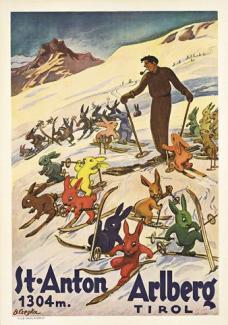
Herbert Bayer "Aspen" poster stood out for historical value.
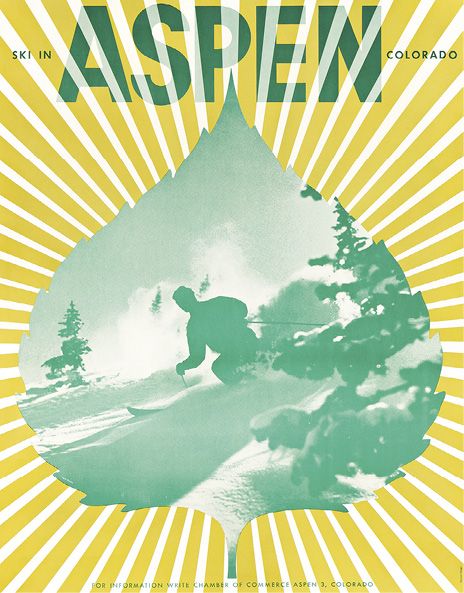
Swann Galleries’ annual vintage poster auction typically includes several classics of the genre, such as this Northland Skis poster with a point of view that shows the brand imprint on the ski tips.
For collectors, the annual vintage posters and graphic design sale at Manhattan’s Swann Auction Galleries is not to be missed, a sale when some of the best, rarest and most unusual ski posters come up for auction and benchmark prices are set.
The February 29 sale was top-heavy with posters from the United States, Austria and Switzerland, with examples from some of the medium’s most acclaimed practitioners.
As always, the auction was conducted by Nicholas Lowry, president of Swann, known for his years as a poster appraiser on PBS’s Antiques Roadshow, deep baritone, three-piece custom-made checked suits and handlebar mustache. Lowry has skied since childhood, and snowsports themes have a particular place in his longtime love affair with the art of the poster.
Some venerable American works kicked off this year’s auction of 42 winter posters. If there was a standout in terms of graphic design and ski history, it had to be Herbert Bayer’s “Ski in Aspen Colorado.” The Austrian-born Bayer, regarded as one of the most influential designers of the 20th century, was trained as an architect and attended the Bauhaus in Weimar and Dessau. He taught advertising, design and typography and became a leader in pioneering the technique of photomontage, integrating photographs into graphic compositions.
Bayer emigrated to the United States in 1938, thanks to an invitation from Alfred H. Barr, Jr., founding director of the Museum of Modern Art. He became an advertising consultant to Walter Paepcke, the catalyst for the development of modern-day Aspen and the owner of the Chicago-based Container Corporation of America.
Bayer moved to Aspen in 1946 and was instrumental in developing the town as a resort and cultural center. He was also the architect for the Aspen Institute and designed the iconic aspen leaf emblem that became the logo for the ski area. This poster, issued in 1946, introduced Aspen to the world as a ski resort. Inside the leaf, a skier is making turns through the powder on Ajax (as Aspen Mountain is also known).
Swann had previously auctioned the poster in the orange-and-white-striped version but never in this yellow-and-white-striped variant. Lowry claims it was the first time this version has ever been auctioned. “The poster is rare to begin with, and this version is very rare,” he says. “It combines the best 20th-century graphic design with a great ski poster. It’s literally the best of both worlds.” The poster went to a lucky collector for $6,750, just over its top estimate of $6,000.
Earl Newman, still alive, is known for designing posters for the Monterey Jazz Festival and the United States Surfing Championships in the 1960s. His poster “Aspen,” from the same era, depicts an athletic skier on a slalom course, using colors that blend and appear to make him a part of the mountain (see magazine cover).
“It is a classic modern American ski poster, and everything about it is great,” says Lowry, as the poster edged just above its high estimate to close at $1,250 (which, like all poster prices mentioned here, includes the buyer’s premium, 25 percent of the hammer price).
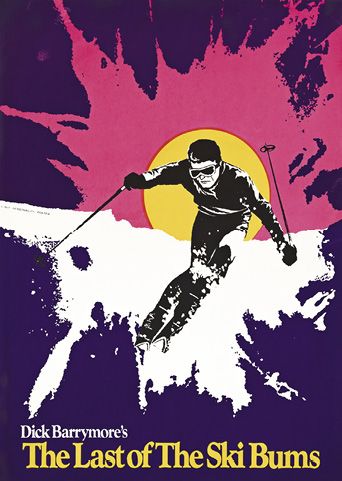
“The Last of the Ski Bums,” from 1969, advertises a movie by Dick Barrymore, a ski version of the film Endless Summer, which had similarly chronicled surfers. It came up for auction at Swann in 2016 and 2022, and here it was again, a bargain at $469, well under its $700 low estimate. In “Fly the Friendly Skies of United/Take a Ski-Lift Holiday,” circa 1968, the anonymous designer uses a photo of a skier in a classic sweater gracefully navigating a steep slope. Yet most of the poster is filled with the badges and logos of the ski areas that the airline served back then, from Vail, Aspen Highlands and Rogers Pass to Alta, Brighton and Whistler. With the piece estimated at $700 to $1,000, the hammer came down at $3,000.
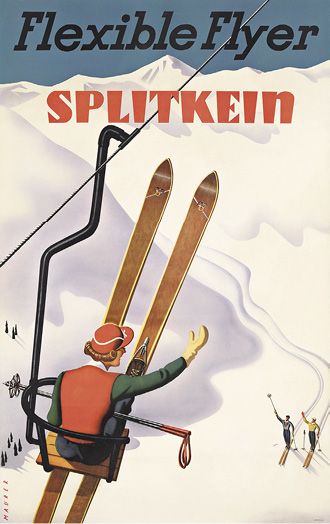
The German-born designer Sascha Maurer, known for his work for the New Haven Railroad, New England ski resorts and ski manufacturers, was represented by his well-known “Flexible Flyer/Splitkein” poster of a woman on a chairlift waving at two friends below.
“Sun Valley/Round House on Baldy Mountain,” by Dwight Clark Shepler, did similarly. Sun Valley images are typically popular sellers at Swann auctions, and this is perhaps the most famous poster of the resort. Yet the 1940s image barely edged over its $2,000 low estimate, to sell for $2,375.
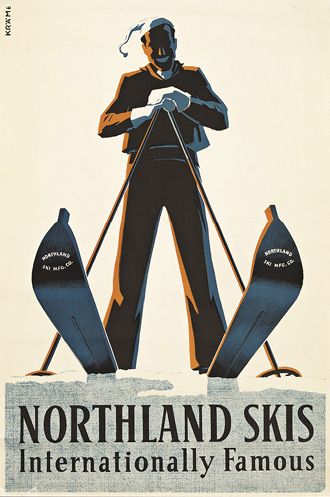
Meanwhile, there were classics like “Northland Skis/Internationally Famous.” It’s a powerful image of a smiling man standing on a pair of wooden Northland skis, designed so that the viewer is looking up and catching the Northland imprint under the tip of each ski.
Some other American ski posters did not fare as well, including an anonymous 1960s poster for “Sugarloaf: A Mountain of Fun” and James Lewicki’s poster of the Stowe trail map, “Stowe/Ski Capital of the East,” both of which went unsold.
While the American posters had a decent showing, the fevered bidding was mainly reserved for some European examples. Lowry describes “St Anton Arlberg Tirol” from 1934 as “a comical and
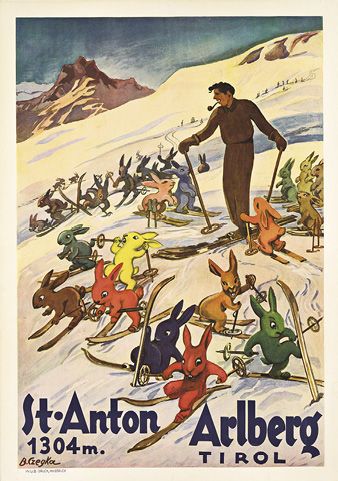
charming poster by Berta Czegka, which shows the legendary ski instructor Hannes Schneider trying to teach a beginner’s class that consists of M&M–colored bunnies on skis. They’re snow bunnies on the bunny hill.” In that time and place, “snow bunny” (kaninchen) referred to any new skier, male or female, while schneehase (snow hare) implied a canny veteran.
Czegka, an Austrian artist, was a passionate skier and joined the Austrian Ski Association in 1911. “It’s a little goofy, a little Disney,” Lowry adds. “It’s a good poster that stops you and makes you smile.” While it’s been widely reproduced, originals are scarce. “We’ve never had it before,” Lowry says. “It’s a great poster, even though it only measures 27 x 19 inches. It has a lot of presence for a small image.” Indeed, it made a powerful impression at this auction, vaulting from its high estimate of $3,000 to close at $7,500.
“
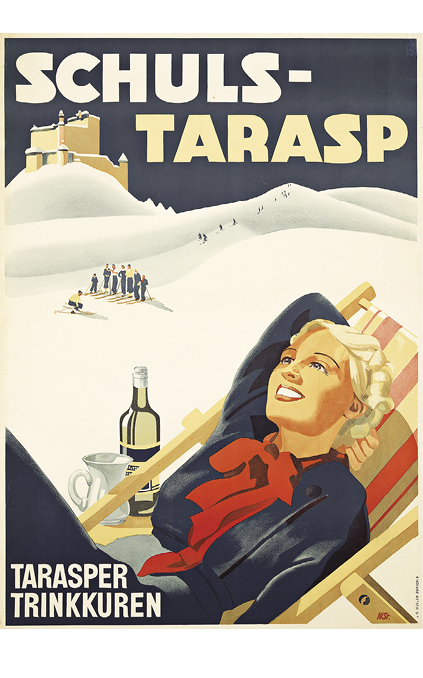
Schuls-Tarasp,” from 1935, portrays a fashionably dressed skier reclining in a chair with a bottle of mineral water and a stein beside her. (Trinkkuren means “drinking cure” or “hydration.”) Some skiers descend a meringue-like slope, while others wait below. Atop the mountain is Tarasp Castle. A small ski area, Tarasp still exists, albeit with a single lift, in Graubünden in eastern Switzerland. “Now this is a ski poster that depicts a woman who likes to exercise as I do, lying in the sun with a bottle and a giant mug,” Lowry quips. ““I like the quieter, easier side of athleticism. I’ve never seen this poster before, but it’s good to know that there were lazy tourists back in the ’30s.” The poster sold for $1,875, just above its $1,500 high estimate.
“Parsenn/Klosters,” a 1934 work by Hugo Laubi, shows three skiers making sweeping turns as they head to a candy-stripe pole bearing the name of the resort, located in the Grisons mountains of Switzerland. The illustration is surreal and a touch cartoon-like. The poster climbed above its high estimate of $2,000 to close at $3,250. “He was a great artist,”
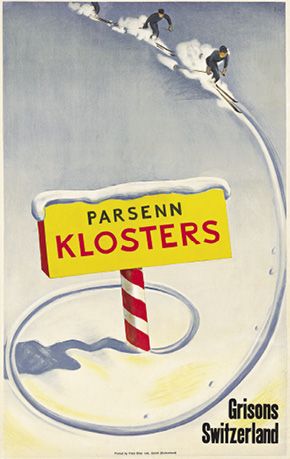
says Lowry of Laubi, known for ski posters of Arosa, Zweisimmen and Zermatt, as well as his classic poster of the annual winter horse races on the lake at St. Moritz, which was also for sale and soared above its $3,000 estimate to close at $7,800.
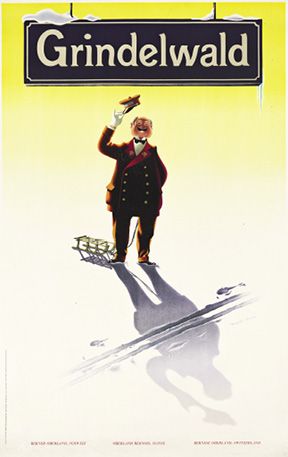
Another playful poster was “Grindelwald,” by Herbert
Leupin. One of the great Swiss poster artists, Leupin infused much of his work with a dry sense of humor and visual gags. This poster shows a concierge standing under the train station sign for Grindelwald, tipping his hat. “If you look closely, you’ll see the concierge’s crossed keys on his lapels,” Lowry points out. “Behind him is the Davos-style sled used to transport the guest’s luggage.”
However, fresh ski tracks replace train tracks, indicating that a guest has just departed on skis. It’s the wry and sublime style of Leupin at work, a ski poster without an actual skier in sight. Estimated to sell between $1,000 and $1,500, it was a bargain at $750.
Among the blue-chip European poster artists, Martin Peikert always stands out. He “has developed a cult following among collectors,” Lowry says. The Peikert poster on sale, “Pontresina/Diavolezza,” shows the front face of the massive Swiss ski mountain while a tram car soars overhead. The 1955 poster is not especially rare nor is it one of Peikert’s most vital images, and it went for $2,125, just over its low estimate.
Swann’s next auction featuring vintage ski posters will be held in March 2025. 
Regular contributor Everett Potter wrote about the history of Sundance Resort in the March-April issue.
